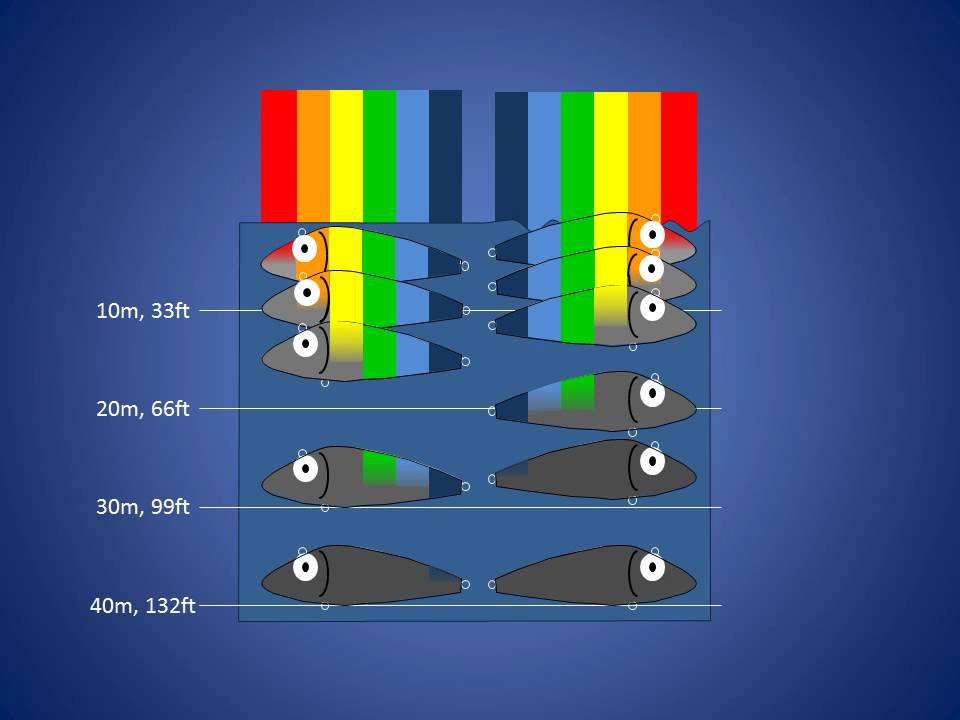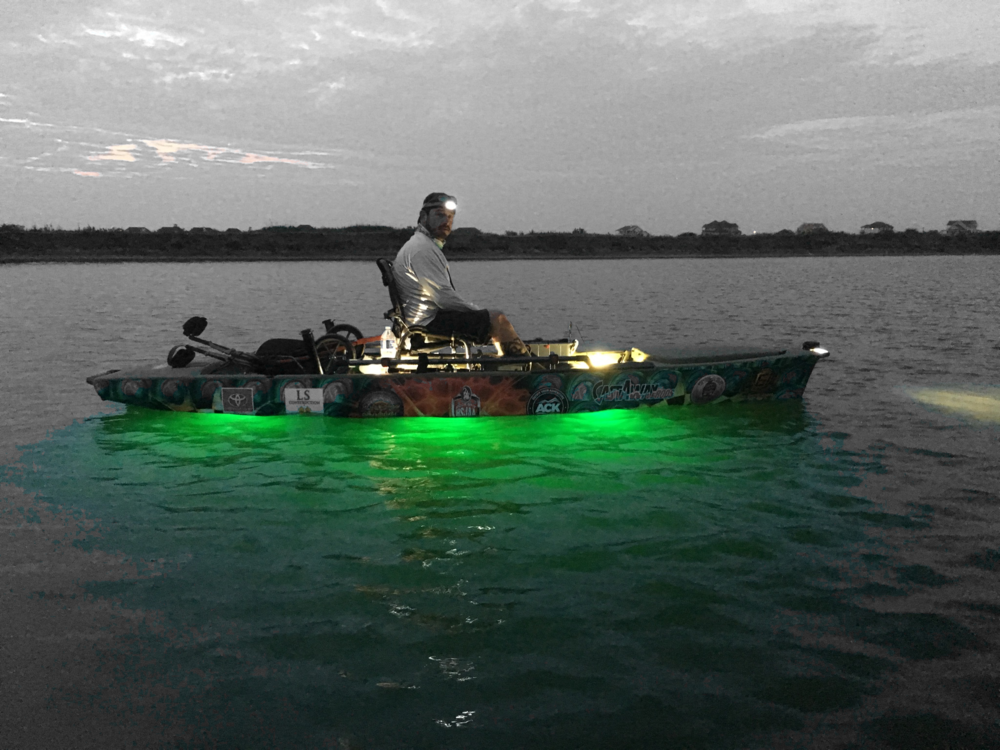Just like mosquitoes, bugs, and then shrimp moving up the food chain, the light will eventually attract baitfish and then bigger fish. Curious in nature, Largemouth and Smallmouth Bass, for the most part, see what we see, but there is one very important difference: Bass can detect colored objects in darker conditions better than we can. In fact, in low light conditions bass only need about one-tenth of the amount of light we need to see. Are Bass Attracted To Light At Night?
- Yes
- Bass are naturally curious predators attracted to:
- Natural forms of light from the reflection of the moon
- Artificial light coming from boats & the shore
- Fish lights provide green, white & blue colors frequencies of the light spectrum that are naturally sensitive to all members of the Bass food chain
Ancient fishermen used torches that threw off a white light which also has a positive effect on attracting fish. That’s why fishermen who use lighting in saltwater and freshwater fishing, today use white color light. Based on the biology of visual receptors that are found in the Bass, contain two pigments colors Green and Blue. Making green, blue, and white popular choices for artificial Fish Lighting.
Can Fish See Lures at Night
Predator fish are always on the move so curiosity is part of their game plan. Bass is tuned in to the sound that can travel some distance and can be heard by the exceptional hearing that is used by Large and Small Mouth Bass have been able to develop over time. Using Bass lures to take advantage of that hearing and use rattles and other sound enforcement to entice the Bass into shore where the angler handles the rest.
Bright colors with noise are often used on Spinnerbait to attract the popular fish just before the sun goes down or on a moonlit night. Even though Bass has a great sense of hearing vibration and sound they like to hunt by sight. Metallic color works best picking up some natural moon reflection and artificial light from shore and other boats on the water.
Busy lakes and rivers that are active with watercraft during the day will bring out the Bass when the sun goes down. This is the best time to fish for Largemouth and Smallmouth Bass on the move and looking to feed. The bass is frequently up in the shallows along bluffs, on shallow humps, and feeding flats, and anglers are usually able to approach within close distance without spooking them.
Sound can travel more than five times faster in water than it does in air, and about five times faster again in solid like steel. The denser the medium, the more particles there are to vibrate and the faster energy can be passed from one particle to another.
To get the most out of your nighttime fishing, use the proper equipment including light. For you and your boat and the Bass looking for his dinner.
In dim light, the bass is unable to detect colors. First to go is always Red, then orange, yellow, blue, and chartreuse all become shades of gray after dark. Try to keep out of the tree shade that blocks the light of the moon that lights up areas on the lake.
Darker color baits create more contrast against the night sky and are easier for upward-looking bass to spot. Blue is the last color to disappear as the light fades with twilight or depth.
Most people indicate that green and white lights will attract the most baitfish at night. Green has the shortest wavelength and is the best color for penetration in freshwater lakes and other intercoastal waterways. In areas with poor visibility, green will also make the water appear cleaner and reflect less particulate.
Colors that Disappear the deeper you go:
- Red-15 foot
- Orange- 25 foot
- Yellow 35-45 foot
- Green-70-75 Foot
Whether a Largemouth Bass is attracted to this color may be questionable but according to researchers even though a Largemouth’s hearing is better than his eyesight the fish’s curiosity is increased while on the hunt and if he is attracted to the color or glimmer in the dark he will go for it. Elements that may help the Bass to see better can be artificial along with natural light like a bright moon on a flat calm lake.
Bass Fishing Color Chart
Color vision is the capability to see and recognize objects based not on how bright they are, but on how well they absorb, reflect or transmit light of different colors. For example, an apple looks red in sunlight because all but the red part of the white light from the sun falling on it is absorbed by the apple’s skin leaving only the red light available for vision. In order to the retina in the back of the eye must have color detectors, called cones, present and the brain has to be wired to make use of the information it gets from the cones.
We have three different kinds of cones in our eyes, called red, green and blue that make human color vision possible. The goldfish has four kinds of cones: red, green, blue and ultraviolet. Other fish have different numbers and kinds of cones meaning that they have the capability of seeing in color. From Ellis R. Loew-Cornell Center for Research
Bass are known by the most avid anglers that Bass can see fairly well but their exceptional hearing added to their makeup which makes them a gamefish to contend with. This is from its physical makeup. The Bass’s frontal lobe located in the fish’s brain is enormous. This means that over the years the fish invests much of its neurological resources in its ability to see. Largemouth Bass have a fixed iris, which is the main reason why they don’t like direct sunlight. This is also one of the reasons why it takes them a while to get used to the low light conditions after sunset before they come out to roam.
Bass are light-sensitive and turn away from well-lit areas. Areas, where there’s a lot of traffic, are not the best as traffic lights are not ideal.
A Bass has a sight called Monocular instead of Binocular which means that in order to get a good view of an object the fish has got to focus both eyes on it. This means the Bass has to be facing the object and using both eyes to process the shape, distance, and image of that object. Once positioned with 2 eyes fixed on the unknown object they might be able to recognize what they are looking at.
They do have the capacity, as all good fishermen know to distinguish colors. Because Bass have Cones in their eyes, they can make out differences underwater. Of course, Color is the product of light and it’s absorbed and refracted by water, and the shorter the wavelength the more that color is farther or deeper the color can penetrate. In clear water, the Blue end of the spectrum is visible at the deepest depth whereas the Red end of the spectrum has the opposite result.
If the water is affected by rain making it cloudy or there are algae blooms involved in the water. That makes the water less clear and will be less likely to absorb and transmit the light of different colors. This is when the angler should use Contrasting Colors to fish for them. Use the opposite colors for the contrast of the fish’s environment so the Bass will be able to notice it and come to investigate it.
So when choosing the color for your lure keep it simple and use ultra-clear water as a reference. Then add in more factors like:
- If the water is stained or muddy
- cloud cover
- wave action-is the surface of the water rough from the wind and how choppy the water is
- light intensity how bright is the sunlight hitting the water
You will get some kind of idea of color absorption and light penetration. Use the basic information offered here to simplify everything without getting too technical:
- When choosing lures on bright days go with brighter colors if you want your lure to be seen at greater depths than the lighter available, the deeper your bait will be visible.
- When choosing lure color during low light conditions or cloud cover, go with darker colored baits (or fluorescent) as there won’t be enough light for a color to be visible at greater depths, the contrast of the darker bait will be more effective. This is also when action, profile, and sound become very important.
Color Chart
Clear Day– Natural colors — white, shiny, watermelon, green, pumpkin, browns, baitfish, and crawfish
Cloudy Water-Dark or fluorescent colors
Stained Water-Bright colors — red, orange, and chartreuse
Thick vegetation, algae-colored water-2-toned colored lures; no green-colors
Also always remember that no matter how much light is absorbed by the water and how clear the day is on the water that if the background environment and lure match in color then the fish will most likely have a difficult time seeing it underwater.
Best Color Artificial Light For Bass
If you are fishing for Bass at night you will need artificial lights that are intended to draw baitfish into the area of you or your boat. The reaction of the Fishing Lights works by attracting tiny animals called zooplankton, which attracts baitfish such as shad, herring, and minnows, which in turn attract predator fish such as bass, crappie, walleye, redfish, speckled trout, and other species. Sportfish gather near or in the circle of light to feed. The angler drops in bait or lures to catch them.
This will work for most species in salt and freshwater. Scientific research shows that all members of this food chain have eyes sensitive to the colors blue and green. A perfect solution for the location around water where it all takes place.
What are the best live Baits for Bass fishing?
Bass are predators they’ll eat pretty much anything smaller than them in their natural environment like:
Minnows
Shad
Crayfish & other crustaceans.
Worms-Nightcrawler
Small Bluegills & small Catfish called “stones.”
Frogs
Insects on the surface-Grasshopper-Crickets-Dragonflies
Yes-Bass will eat smaller Bass …………………………………………………………………………………… Read more
The 3 Primary Types of Fishing Lights are:
- Submersible Lights- are considered the best and can attract a wide array of fish to your Dock or of the side of a fishing boat. A good one here is in our recommended section product page. Green Blob Outdoors Underwater Fishing Light, LED with Timer 7500/15000/30000 Lumen Fish Attracting Light, Snook (30000 Lumen)
can be used in fresh and saltwater and are very bright with a long time span and use little energy during their usage.
- Floating –Floating lights with more energy-efficient LED or fluorescent illumination are widely available and in assorted colors. You can power these types of fish lights with standard 12-volt alligator clips, a cigarette-lighter plug, or alkaline batteries. The best lights are fused for safety and have long insulated chords that are dependable and safe.
- Black Light– is more of an aid to see at night. They illuminate fluorescent monofilament, making it more visible over a greater distance. When the ultraviolet lights are on, you can keep an eye on your line and watch for the slightest twitch or movement indicating a bite. This HERCULES Braided Fishing Line 2000m 2187yds 10lbs-200lbs Pe Superline 8 Strands (Fluorescent Green 200lb/90.7kg 0.75mm)
is a highly recommended brand that will work well with the Blacklight.
- Overhead Dock Lights- Big Fish Lights like these can be assembled and hardwired on your Dock or Pier and will bring the fish to you by creating the perfect environment for fishing. Permanent lights are typically powered with a 115-volt house current. The problem with overhead and floating types of lights are that they are affected by reflection off the top of the surface of the water.
Are Largemouth Bass Attracted to Sound?
Largemouth Bass have 2 sensors for investigating acoustical disturbances. One in its inner ear & another in the lateral line on its body. Both work off each other to hear & feel vibrations. Despite a Bass’s lack of hearing high frequencies, its curious nature attracts it to all & any kind of sound ….…………………………………………………………. Read more
LED Boat Lights-Any kind of fishing vessel will have an advantage on fresh or saltwater with fishing lights added to any size Boat, Kyack, SUP that is being used to fish at night. Most LED lights will attract fish and make your vessel stand beautifully on the water. Lighting will call the fish into you rather than you looking for them.
LED boat lights are proven to attract swarms of baitfish and insects around the hull of the boat. As mentioned above, using white or green lights slightly submerged about 3-6 inches will generate a ton of baitfish activity which will lure the bigger guys in.
The big difference between night and day fishing and using the favorable colored lights to draw in fish is that you can maximize the ability for catching fish by creating favorable conditions for them and for their food source. Where there are baitfish you’ll find insects and predatory fish. Game fish usually are in the area in which their food is most concentrated.
For baitfish, shrimp, and even insects, all of which are food for game fish, it’s been known that they are attracted to light at night. So, if you can attract the bugs then the bait, and the game fish will likely come. This is the purpose of night fishing lights.
The best lights should be bright or have a high intensity. The intensity of visible light or brightness is measured in a unit called lumens. The more lumens something has, the brighter it will be. To give you some sense of scale let’s say a typical 100 Watt incandescent light bulb has about 1500 lumens. A heavy-duty flashlight can have up to around 5000 lumens.
The Power Source should be equal to or a little higher than your Fish light’s needs. The light specs should have a voltage rating to make sure the battery pack rating is at least as large as that. There are also bigger and better more powerful lights for piers and bulkheads that use AC power like the Green Blob Underwater Fishing Light that we endorse in the above paragraph.
These produce high Lumens, in fact, the highest Lumens on the market today, and with the advantage of being indefinitely powered at a stationary location.
Battery capacity is dependent on the amount of time you will run the light in hours.
which can be calculated by this equation: Amp Hours (Ah) = Light Wattage (W) x time to run (hours) / Battery voltage (V)
For example, for a 12-volt battery and a light that requires 8 watts and you want to run it for 3 hours, the Amp Hours rating for the battery should be (12 x 3) / 8 which equals 4.5 Ah. The higher the Ah, the longer you can run your light.
Night Fishing Largemouth Bass
- To Fish Largemouth Bass at night focus on the shallows night and if there was an activity during the day wait for the water to calm down.
- the fish among brush piles, sandy beach areas, boating docks, swimming floats, and along rocky ridges.
- Colors won’t work at night for Bass or any other fish
- Everything appears grey so use lures that incorporate sound to get Laregemouths attention like a Jitterbug that makes a lot of surface noise that a Largemouth will be attracted to.
- Use shiny reflective Spoons and Sinners that will attract some attention
- Avoid bright lights or loud noise onshore
Are Largemouth Bass Attracted to Scent?
Yes, According to most anglers, they use scents on soft baits mainly Shad, Crawfish, and minnow-Natural scents because it is a favorite Largemouth food along with salt, anise, garlic, or for its uses in hiding human contact and chemical scents from manufacturing …………………………………………………………………………………. Read more
JimGalloway Author/Editor
References: A Look At Bass-article from Bassmaster


